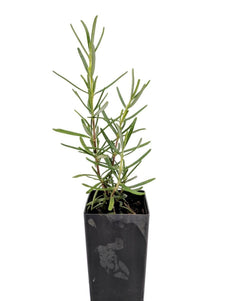
Rosemary - Portuguese Pink Rosemary
Rosemary - Portuguese Pink Rosemary

- In stock, ready to ship
- Inventory on the way

Usually available: All year
Life cycle: Perennial
Height: 1.2 - 1.75
Position: Full sun
Soil preference: Well drained
This is how we pack and send your Herb Plants to all states except TAS & WA
You will receive
- 1 Portuguese Pink Rosemary Herb Plant in a 50 X 75mm tube - General growing instructions
All of our Herb Plants are grown organically with certified organic potting mixes and fertilizers
Botanical Name: Rosmarinus officinalis 'Portuguese Pink'
Rosemary ‘Portugese Pink’ is an upright, evergreen shrub growing from 1.2 to 1.75 meters high by 75cm wide. The glossy green-grey needle shaped leaves are highly aromatic and very suitable for culinary use. The flowers arrive in late summer and autumn, a little later than some other varieties. This plant produces a clear pink flower said to be the best of all pinks, but blue and white flowers may also sometimes appear.
Rosemary ‘Portuguese pink’ prefers part to filtered sun and tolerates moderate frosts, dry periods and coastal soils. The best climate range extends from cool temperate to subalpine regions, a slightly different range than other varieties. This variety is quite rare and a close relative of Rosemary ‘Tuscan Blue’. Like most, it is good for hedging and its large size and dense form is even suitable for topiary.
Rosemary General
Rosemary is an evergreen, woody shrub native to the Mediterranean region of Europe. It belongs to the Lamiaceae or mint family, with the botanical name Rosmarinus officinalis. This name is from the Latin words ‘ros’ meaning dew and ‘marinus’ from the word for sea. Together they refer to the ‘dew of the sea’, because these plants grow in near coastal areas. There are many varieties, distinguished by being upright or prostrate, ranging in size from low ground covers to large shrubs reaching 1.5-2 meters high. The leaves are small and often needle like, ranging from green to grey-green with a pine like aroma produced by the essential oils in the foliage. The small flowers are bee attractants and range from pale pink, purple, white, and include a range of distinctive blues. They usually bloom from early spring to summer, sometimes with a new flush in autumn.
Rosemary is a hardy plant that needs little attention once established. Soil should be well drained and slightly alkaline, the aspect should have full sun or partial shade and plants require occasional watering. Rosemary is tolerant of dry periods, coastal conditions, poor soil, hot and windy aspects and even has moderate frost tolerance. Humid conditions, wet soil or excessive frost will cause problems for the roots and foliage. Plants may be pruned to shape, with larger varieties being suitable for hedging. Propagation from cuttings is easy for most home gardeners.
Most people know rosemary as a culinary herb, especially in Italian cuisine. However, this herb also has a history of medicinal use, including being reputed to improve memory. Of course, many gardeners grow Rosemary ornamentally or just for the lovely fragrance it imparts to the garden.
For more information on history, growth conditions, culinary and medicinal use please see our Common Rosemary listing and other varieties such as Tuscan Blue.
All information provided on this website is for informational purposes only. Please seek professional advice before commencing any treatment.




